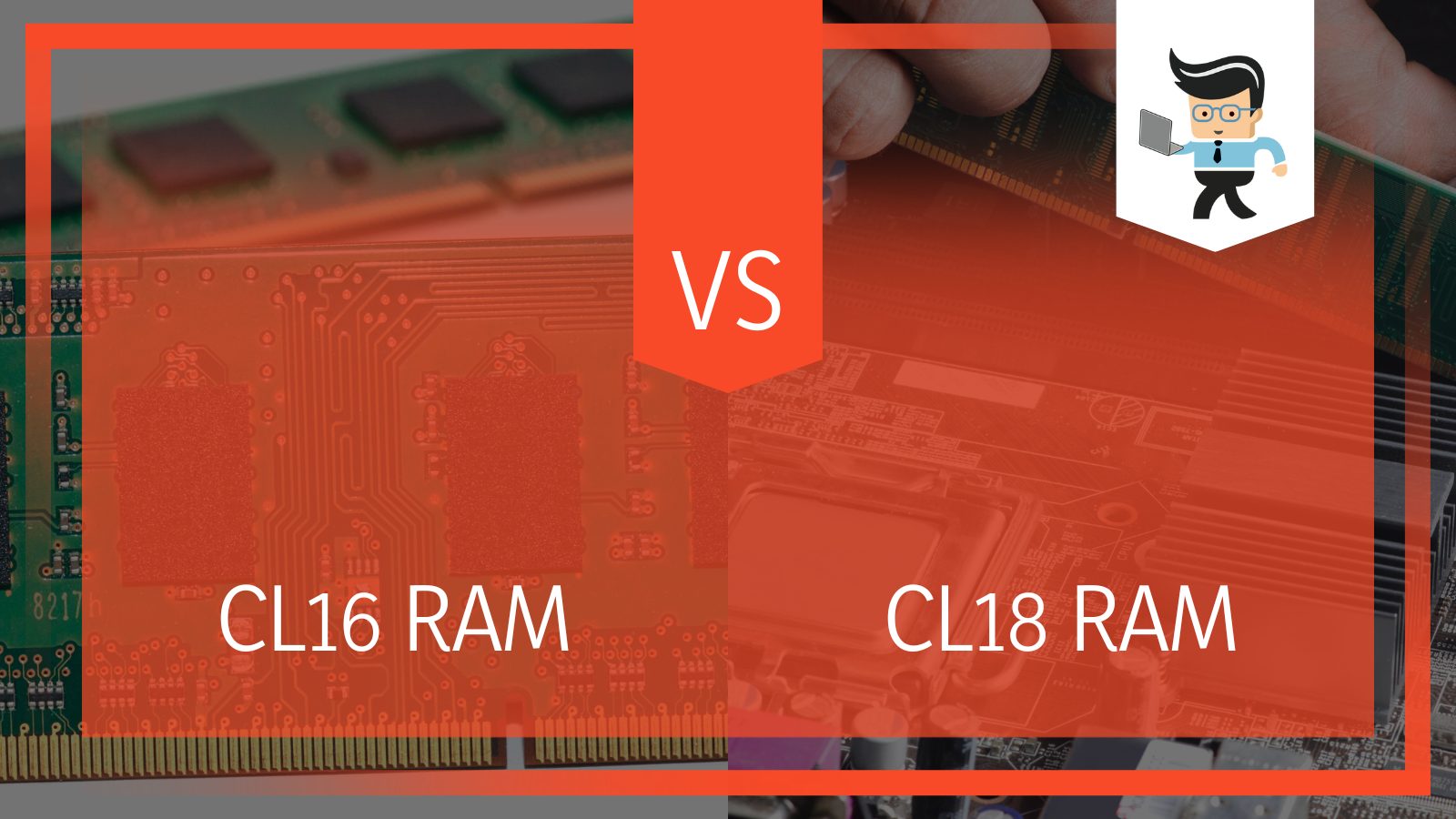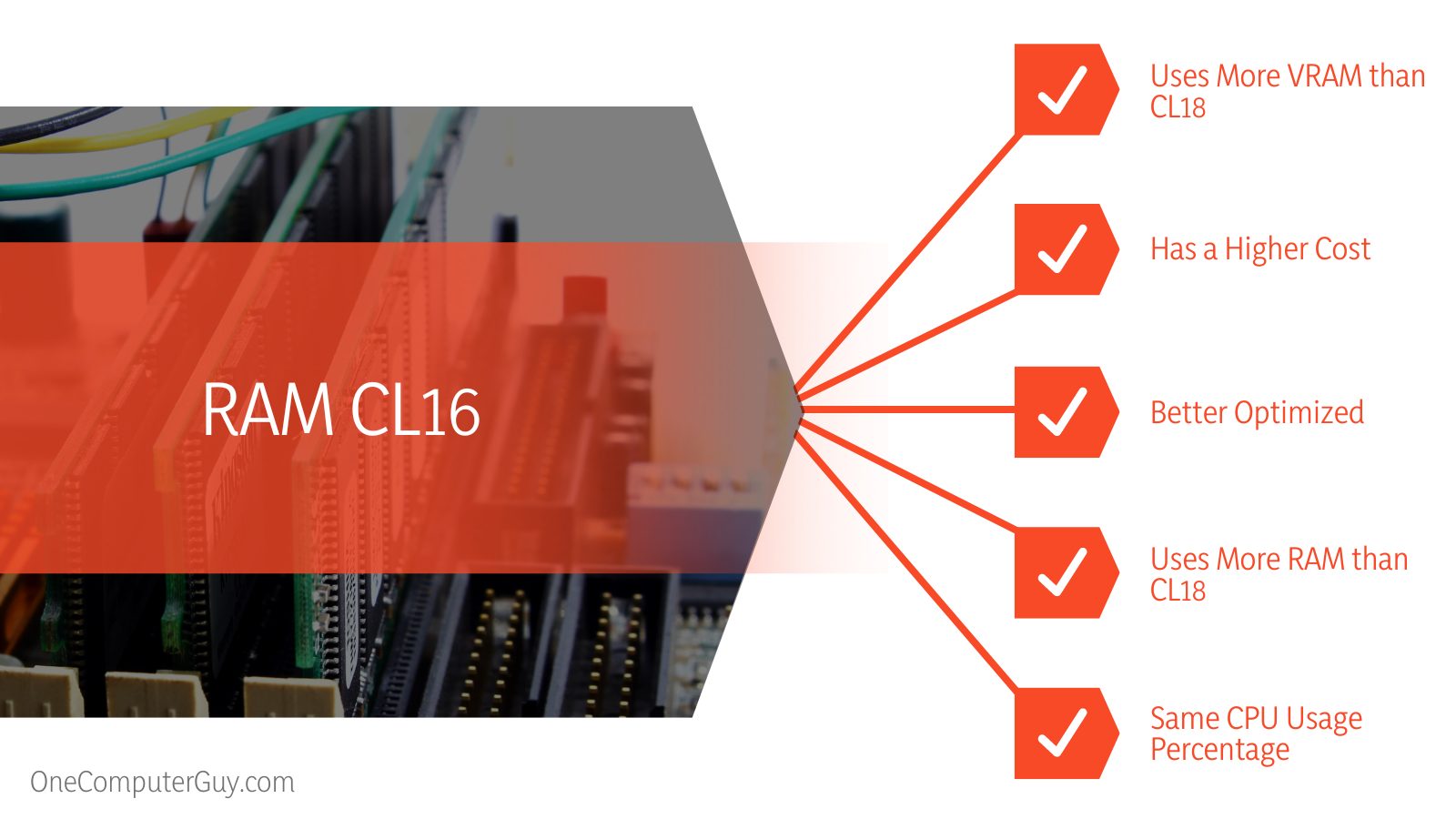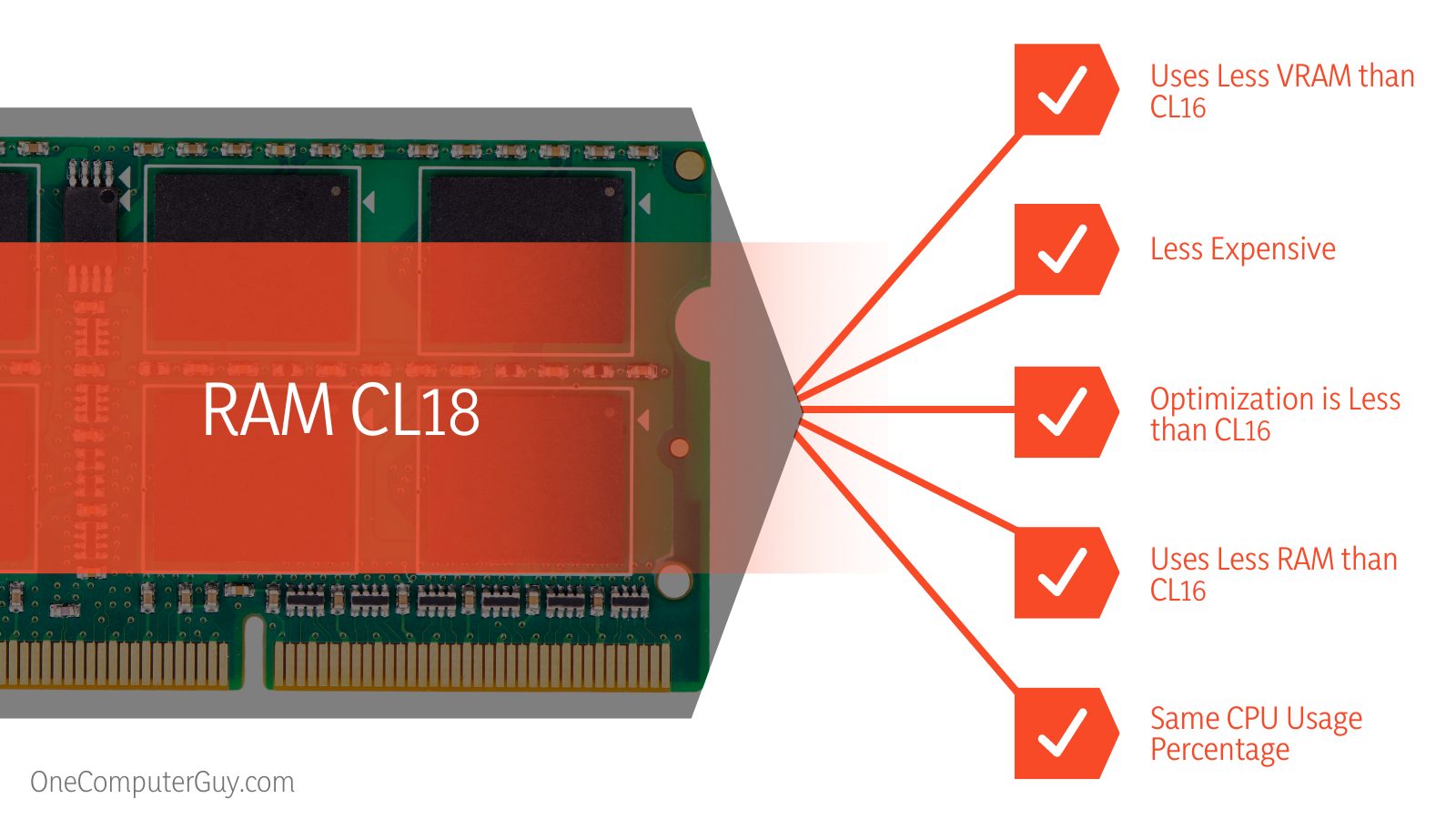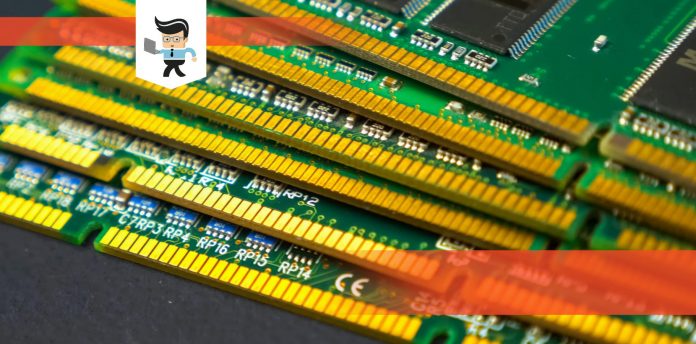CL16 vs CL18 is a topic you can’t avoid when deciding the RAM to buy for your PC rig. Your computer’s speed is partly determined by your RAM so choosing the one with the ideal CL is sure to provide significant benefits to your PC.
 The type of RAM you choose also has an effect on your computer’s overall performance so it’s only right that you know the differences between a good RAM and a great one.
The type of RAM you choose also has an effect on your computer’s overall performance so it’s only right that you know the differences between a good RAM and a great one.
In this complete guide, we’ll be taking a look at the differences between these two memory types to help you decide on the ideal one for your computer.
Contents
CL16 vs CL18 Comparison Table
| Features | CL16 RAM | CL18 RAM |
| VRAM Usage | Uses more VRAM than CL18 | Uses less VRAM than CL16 |
| GPU Usage Percentage | A little higher than what you’d experience using a CL18 | Fluctuates — sometimes lower than CL16 by a small margin, sometimes the same rate |
| CPU Usage Percentage | No difference from what you get on the CL18 | The same with what you get on the CL16 |
| GPU Temperature | Typically less than what you get on the CL18 but can reach the same degree | Has a temperature that’s similar to CL16 but can go up by a small margin |
| RAM Usage | Uses more RAM than CL18 | Uses less RAM than CL16 |
| Cost | Has a higher cost | It’s less expensive than CL16 |
| Optimization | Better optimized | Optimization is less than what you have on the CL16 |
What Are the Differences Between CL16 vs CL18?
The main difference between CL16 and CL18 is their speed and performance — while typical CL18 RAM can process more information than a CL16 memory kit, it does so at a slower pace than what you experience on a CL16 memory module. In short, CL16 has more speed while CL18 offers better performance.
– Speed
A CL of 14 to 16 often comes with RAM kits that have a speed of 3200MHz while those with a speed of 3600MHz often feature a CL range of 15 to 19. CL14 to CL16 memory kits have a larger range than those in the 15 to 19 category.
This means that even though a CL18 3600MHz RAM has better speed than a CL16 3200MHz RAM, the CL16 will provide better overall performance. Therefore, you’ll need to get RAMs with lower CL if you’re build a rig that’s keen on performance.
 – Memory Latency
– Memory Latency
You might be wondering if there is any difference between CL and memory latency. Both terms are interrelated as memory latency is determined by the speed of the RAM. The faster the RAM module, the lower the memory latency.
With a lower RAM latency, your RAM would be able to access its memory multiple times a second while reducing the time between cycles. Also, a RAM with a lower CL range can provide faster performance in fewer cycles compared to a RAM with a higher CL rating.
Let’s take a look at a 3200MHz CL16 memory kit versus a 3600MHz CL18 memory kit to better understand this process. Using the aforementioned speeds, the CL16 memory module would be faster than the CL18 RAM when performing tasks. Both CL types have similar latency, although the CL18 memory is a bit slower.
But there’s a good chance the CL16 would process data in two fewer cycles than the CL18 RAM. Assuming both RAMs share the same 3200MHz speed, there would be a much broader margin between both and you would notice little to no difference between both RAMs.
– CPU and RAM Performance
Different CPUs provide RAMs with different outputs. Below are how some of the most popular processors that affect CL16 and CL18 RAMs.
AMD Processors
AMD Ryzen processors tend to lean towards RAM speed than their Intel counterparts. These processors often feature fast memory speeds but their overall performance are usually not up to par. AMD CPU chips and their CPU cores have a specific clock time feature known as the Infinity Fabric Core System.
The system features its own unique clock cycle termed the FCLK, which often comes with clock speed that ranges from 1800MHz to 200MHz. Therefore, if you have an AMD Ryzen processor and you’re looking to buy a RAM, you can disregard clock speed and instead focus on getting a memory stick with a lower CL.
Doing so will ensure that you get the most out of the tight CPU clock cycles by minimizing the number of cycles your system needs to process a command.
So if you’re trying to choose between a 3600 CL16 vs 3600 CL18 RAM, the CL16 version would be beneficial than the CL18 RAM stick. However, if you have purchased a CL18 stick already, you can use it with your Ryzen CPU though you may experience some difference in performance, especially during gameplay.
Intel Processors
For those using an Intel processor, you want to do the opposite of what we’ve explained above. Intel processors don’t have limited clock cycles like their AMD counterparts. Therefore, you’re likely to get the best performance from your Intel CPU when you use a memory stick with high speeds.
You can easily overclock a memory stick with high speeds and CL from 18 to 16, allowing you to enjoy better performance than what you’d get from a high speed CL18 memory stick that’s on a Ryzen.
– CAS Latency
CAS Latency, otherwise known as CL or Column Access Strobe Latency, is a factor that determines the speed and performance of your RAM. CL represents the number of clock cycles your RAM needs to follow to execute a command it has received from your processor. In other words, it is how fast your computer’s RAM processes, prepares and executes data after getting the order from your CPU.
 When your RAM tries to get data from one of its memory columns, it represents the time delay in clock cycles. This time measurement is only used by synchronous DRAMs as asynchronous DRAMs use nanoseconds as their time measurement.
When your RAM tries to get data from one of its memory columns, it represents the time delay in clock cycles. This time measurement is only used by synchronous DRAMs as asynchronous DRAMs use nanoseconds as their time measurement.
With that being said, we can consider CL to be the number of clock cycles a RAM module needs to gain access to a specific set of data stored in one of its columns and provide that information to its output port once it gets the necessary command from the memory controller.
Now CL16 memory or RAM with CAS latency 16 can be said to have a CAS 16 timing. This means that the RAM needs 16 clock cycles to get information from its columns and send the information out to one of its outputs.
Regardless of what your memory speed might be, it’s always better to get a RAM kit with low CL. So when you’re on the market for a high-performance RAM, always make sure the product you choose is one with a low CL.
– CL and RAM Speed
The speed of a RAM module isn’t as straightforward as many people think. It depends on a variety of factors, and clock speed, which many people use to determine speed, is just one of those factors.
Other elements such as data transmission speed and the volume of data the RAM can send, receive, and output from the CPU are also factors that help determine the speed of a RAM. However, you can use your RAM’s clock speed and CL simultaneously to determine the true speed of your RAM.
The CL range of a RAM often changes according to the speed the RAM is designed with. Memory speed is measured in Megahertz and it simply refers to your RAM’s clock speed. The clock speed is an element that helps determine the number of times your RAM can gain access to its memory in one second.
Manufacturers often print the CL of their RAMs on the stick itself or post it on their websites. You’ll find the CL of a stick among the first three or four numbers printed on the stick with the first number indicating the CL.
– CAS vs RAM Latency
Just as CL plays a major role in determining the speed and performance of a RAM, it also works with other factors to determine your RAM’s latency.
Memory latency refers to the period of time it takes the RAM to finish a clock cycle, which is often determined by the amount of speed the RAM has. In simple terms, higher memory speeds mean lower memory latency, which contributes to better performance.
This is a more complex subject but what you need to know is that you’re likely to find numbers that are structured like this “6-8-8-22” when reading your RAM specs. These four figures refer to the amount of time your RAM needs to finish different tasks, and the lower the figures are, the speedier your RAM would be.
– CL vs Data Transfer Rates
Many people often consider CL to be the same as data transfer rates. But the truth is, these two factors can be different for memory modules. Two RAM modules with the same data transfer rates can have different CAS timings. For instance, the data transfer rate and CAS timing of the DDR4 3200s are different from each other.
What Are the Characteristics of a CL16 RAM?
The CL16 memory kit is one that has a CAS latency of 16. This means that the RAM takes up to 16 cycles to complete a function or task. The lower the latency, the better the speed at which the RAM completes its cycle. CL16 sticks are ideal for Ryzen CPUs.
What Are the Characteristics of a CL18 RAM?
A CL18 RAM is a RAM stick that has a CAS latency of 18. CL18 memory sticks utilize up to 18 cycles to complete a task, function, or command they’ve gotten from the CPU. CL18 sticks are good for Intel CPUs.
Conclusion
With our explanation above, you can easily come to the conclusion that a CL16 memory module would easily outperform a CL18 memory stick. The CL16 doesn’t need as many cycles as the CL18 to process a command, irrespective of what the actual RAM speed is.
You can only get better performance from a CL18 if you’re using an Intel processor. And even with that, you may need to overclock your CL18 RAM to get it to work as fast as a CL16 memory kit.







